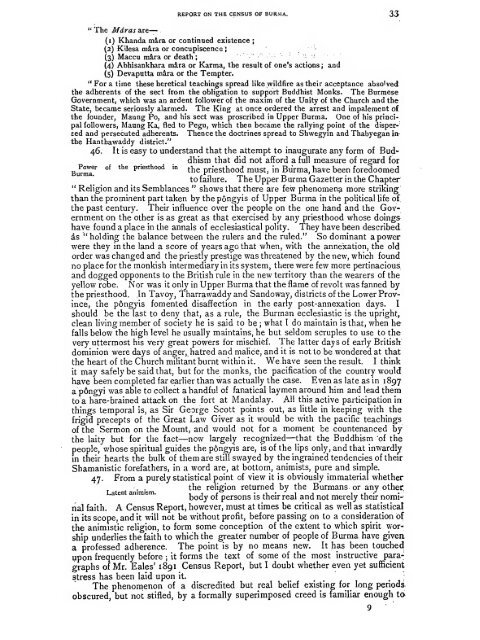Burma: Census of India 1901 Vol. I - Khamkoo
Burma: Census of India 1901 Vol. I - Khamkoo
Burma: Census of India 1901 Vol. I - Khamkoo
Create successful ePaper yourself
Turn your PDF publications into a flip-book with our unique Google optimized e-Paper software.
' "<br />
!<br />
'<br />
REPORT ON THE CENSUS OF BURMA. 33<br />
" The Mdras are— .<br />
(i) Khanda mira or continued existence ;<br />
(2) Kilesa mira or concupiscence J<br />
! -<br />
'<br />
(3) Maccu mira or death; y f<br />
'<br />
(4) Abhisankhara mira or Karma, the result <strong>of</strong> one's actions ; and<br />
(5) Devaputta mara or the Tempter.<br />
" For a time these heretical teachings spread like wildfire as their acceptance absolved<br />
the adherents <strong>of</strong> the sect from the obligation to support Buddhist Monks. The Burmese<br />
Government, which was an ardent follower <strong>of</strong> the maxim <strong>of</strong> the Unity <strong>of</strong> the Church and the<br />
State, became seriously alarmed. The King at once ordered the arrest and impalement o£<br />
the founder, Maung Po, and his sect was proscribed in Upper <strong>Burma</strong>. One <strong>of</strong> his principal<br />
followers, Maung Ka, fled to Pegu, which then became the rallying point <strong>of</strong> the dispersed<br />
and persecuted adherents. Thence the doctrines spread to Shwegyin and Thabyegan inthe<br />
Hanthawaddy district."<br />
46. It is easy to understand that the attempt to inaugurate any form <strong>of</strong> Buddhism<br />
that did not afford a full measure <strong>of</strong> regard for<br />
BuT r ° f the pr!esthood in the priesthood must, in <strong>Burma</strong>, have been foredoomed<br />
to failure. The Upper <strong>Burma</strong> Gazetter in the Chapter<br />
" Religion and its Semblances " shows that there are few phenomena more striking<br />
than the prominent part taken by the pongyis <strong>of</strong> Upper <strong>Burma</strong> in the political life <strong>of</strong><br />
the past century. Their influence over the people on the one hand and the Government<br />
on the other is as great as that exercised by any priesthood whose doingshave<br />
found a place in the annals <strong>of</strong> ecclesiastical polity. They have been described<br />
as "holding the balance between the rulers and the ruled." So dominant a power<br />
were they in the land a score <strong>of</strong> years ago that when, with the annexation, the old<br />
order was changed and the priestly prestige was threatened by the new, which found<br />
no place for the monkish intermediary in its system, there were few more pertinacious<br />
and dogged opponents to the British rule in the new territory than the wearers <strong>of</strong> the<br />
yellow robe. Nor was it only in Upper <strong>Burma</strong> that the flame <strong>of</strong> revolt was fanned by<br />
the priesthood. In Tavoy, Tharrawaddy and Sandoway, districts <strong>of</strong> the Lower Province,<br />
the pongyis fomented disaffection in the early post-annexation days. I<br />
should be the last to deny that, as a rule, the <strong>Burma</strong>n ecclesiastic is the upright,<br />
clean living member <strong>of</strong> society he is said to be ;<br />
what I do maintain is that, when he<br />
falls below the high level he usually maintains, he but seldom scruples to use to the<br />
very uttermost his very great powers for mischief. The latter days <strong>of</strong> early British<br />
dominion were days <strong>of</strong> anger, hatred and malice, and it is not to be wondered at that<br />
the heart <strong>of</strong> the Church militant burnt within it. We have seen the result. I think<br />
it may safely be said that, but for the monks, the pacification <strong>of</strong> the country would<br />
have been completed far earlier than was actually the case. Even as late as in 1897<br />
a p6ngyi was able to collect a handful <strong>of</strong> fanatical laymen around him and lead them<br />
to a hare-brained attack on the fort at Mandalay. All this active participation in<br />
things temporal is, as Sir George Scott points out, as little in keeping with the<br />
frigid precepts <strong>of</strong> the Great Law Giver as it would be with the pacific teachings<br />
<strong>of</strong> the Sermon on the Mount, and would not for a moment be countenanced by<br />
the laity but for the fact—now largely recognized—that the Buddhism <strong>of</strong> the<br />
people, whose spiritual guides the pongyis are, is <strong>of</strong> the lips only, and that inwardly<br />
in their hearts the bulk <strong>of</strong> them are still swayed by the ingrained tendencies <strong>of</strong> their<br />
Shamanistic forefathers, in a word are, at bottom, animists, pure and simple.<br />
47. From a purely statistical point <strong>of</strong> view it is obviously immaterial whether<br />
. . the religion returned by the <strong>Burma</strong>ns. or any other.<br />
r<br />
"<br />
body <strong>of</strong> persons is their real and not merely their nominal<br />
faith. A <strong>Census</strong> Report, however, must at times be critical as well as statistical<br />
in its scope, and it will not be without pr<strong>of</strong>it, before passing on to a consideration <strong>of</strong><br />
the animistic religion, to form some conception <strong>of</strong> the extent to which spirit worship<br />
underlies the faith to which the greater number <strong>of</strong> people <strong>of</strong> <strong>Burma</strong> have given<br />
a pr<strong>of</strong>essed adherence. The point is by no means new. It has been touched<br />
upon frequently before ; it forms the text <strong>of</strong> some <strong>of</strong> the most instructive paragraphs<br />
<strong>of</strong> Mr. Eales' 1891 <strong>Census</strong> Report, but I doubt whether even yet sufficient<br />
stress has been laid upon it.<br />
The phenomenon <strong>of</strong> a discredited but real belief existing for long periods<br />
obscured, but not stifled, by a formally superimposed creed is familiar enough ta

















